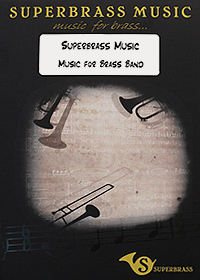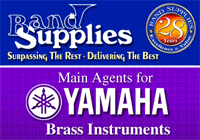National Youth Brass Band of Great Britain
6-Apr-2005Conductors: Dr Nicholas J Childs and Garry Cutt
Guest Soloist: Lesley Howie
Manchester Cathedral
Saturday 2nd April
At the end of a glorious spring day, Manchester Cathedral hosted the cream of the UK's youth brass band players in a concert that brought its Easter course to a conclusion.
During the week, the youngsters had worked with some of the world's finest players as tutors in their respective sections, and then under the guidance of Dr Nicholas Childs and Garry Cutt pulled the entire repertoire together for two concerts; this one in the superb surroundings of Manchester Cathedral and the previous evening in York.
Artistic Director, Elgar Howarth, whose term of office in the role, comes to a conclusion this summer, devised the choice of programme. Some of the finest bands around would have found the repertoire hard on the lips, but the NYBBGB took it in their stride and although a little tired towards the end, performed to a very high standard that brought great credit on themselves.
Whilst the programme was designed to test the players to a level that reflects their talents, these two concerts were also an opportunity for loved ones to see their off spring, perform as well. That doesn't necessarily mean they are banding enthusiasts, and possibly therefore, music a little less demanding on the ear would have fitted quite acceptably into the concerts just as well as the demanding items that were on display.
The opening three pieces of the evening were all Howarth compositions and were conducted by Dr Childs. The first piece, entitled ‘Crystal' was written for Garry Cutt to commemorate his time and achievements at the Marple Band. The music is in the form of a fanfare and what was immediately noticeable was the attention to detail in the overall sound in relation to the acoustic of the cathedral.
Next up was a piece called ‘Parade', part of a suite that Howarth composed when he was seventeen, and his first composition for brass band. The other two movements have remained unperformed, but in ‘Parade' you can readily identify the unique style that has appeared in his compositions down the years.
The band coped extremely well with the work that I have to confess I had never heard before but wouldn't mind hearing again. It certainly wasn't beyond the capabilities of this group of players and they respond to Dr Childs' direction.
The centrepiece of the first half was the performance by Lesley Howie of Howarth's ‘Concerto for Tenor Horn and Band,' the World Premiere of which was given at the RNCM Festival of Brass in January by the Grimethorpe Band and Sandy Smith.
Sandy was due to be performing the work again at these Easter concerts but had to withdraw due to personal reasons so Lesley stepped in. Black Dyke's Principal Horn player has recently recorded the work with Eikanger and was in terrific form on the night. The band also deserves praise as well as reduced to a more traditional size; they were excellent in accompanying the soloist in a work that demands maximum concentration.
What really impressed on the night was Lesley's understanding of the music and this was none more evident than in the Adagito and the closing moments of the final movement that had a real hallmark stamp of authority and a sense of driven purpose.
Unless my ears deceived me, the work appears to have musical references to Bingham's ‘Prague' and having heard the work at the RNCM Festival in January, this second performance was made all the more enjoyable by some subtle nuance from both the soloist and the MD in moulding the eloquent lines of the work so neatly.
To close the first half, George Lloyd's ‘Diversions on a Bass Theme' was performed. Commissioned for the Mineworkers Festival in 1986, this work was also used as the Open test piece a few years ago, won in Birmingham by Faireys. It is something of a musical play on a word as although the initial thematic line of the work is a passacaglia ground bass theme, the title in fact relates to the name of the brewing company (pronounced ‘Bass' as in the fish) who provided the funds for the composition.
The band got back to its full numbers really seemed to enjoy this work, which is a joyful and elegant composition, and once again they responded to the MDs direction in great fashion. Dr Childs' direction was fairly typical of what the banding public has become used too in recent times and he certainly signed off his part of the concert with a performance that was impressive from the first note right to the last.
Those that thought the first half was tough going had to steel themselves for the second half that was equally as demanding both for players and the audience.
Garry Cutt took to the podium for music for the pen of Wagner. First up was ‘Siegfried's Funeral March', and it received a sensitive, yet powerful reading. The poignancy of the stately march was captured with precision and Garry Cutt kept a tight control of the dynamics right through to the end, which gave this performance a touch of added class, when it could have easily just been a overblown mess.
The final programmed music was the tour de force, ‘Tristan and Isolde' arranged by Alex Owen and edited by Elgar Howarth. This was Owen's grand Opus, the masterpiece of his creative arranging talents (he was self taught, brought up as he was in an orphanage in the mid 1850's)
This work really is a classic that not surprisingly, doesn't get played that often as it lasts around thirty minutes. Every section of the band is tested and the principal players get a severe examination in a number of the solo passages.
On this occasion though, the soloists shone out magnificently. Thomas Hutchinson on Principal Cornet, David Moore (flugel) and Rachael Botham on trombone all reproduced their individual solo lines standing in front of the band without any problems at all. Garry Cutt sucked the audience in though and it was gripping listening with some delightfully executed ensemble playing throughout.
By its conclusion, the sound of the band sounded a little tired which is perfectly understandable. Throughout the night though, Rebecca Crawshaw on soprano from Fairey's produced many a fine moment as did the horns led by Kate Eggleshaw and euphoniums with Emma Farrow and Ryan Gray leading the way. For such young players to produce such a performance as this, was simply staggering though, and even though it was an exceptionally ambitious choice, it was a choice that was fully justified with the standard of musicianship on show.
The encore of ‘Punchinello' almost seemed a touch out of place after a demanding programme but brought some light relief to players and audience alike.
Manchester Cathedral was full to bursting point on the night and that is testament to the administration of Philip Biggs, the commitment of all the staff involved (including tutors and two of the finest conductors around in Nicholas Childs and Garry Cutt) and most notably the players themselves, who can be proud of their achievements.
Under Philip's guidance, the NYBBGB continues to flourish and perform programmes that will give them plenty of experience as their musical careers continue in the years to come, and this was a concert that should deservedly live long in their memories.
Malcolm Wood.









